Rec. ITU-R M.1225
1
RECOMMENDATION ITU-R M.1225
GUIDELINES FOR EVALUATION OF RADIO TRANSMISSION
TECHNOLOGIES FOR IMT-2000
(Question ITU-R 39/8)
(1997)
Page
2
2
3
3
4
6
6
6
6
6
6
7
7
7
7
7
7
7
8
8
8
8
8
9
9
9
9
Rec. ITU-R M.1225
1
2
3
4
5
6
7
8
9
CONTENTS
Introduction ....................................................................................................................................................
Scope..............................................................................................................................................................
Structure of the Recommendation..................................................................................................................
Related documents .........................................................................................................................................
Radio transmission technology considerations ..............................................................................................
Radio transmission technologies functional blocks ..........................................................................
5.1
Multiple access technology...............................................................................................
5.1.1
5.1.2
Modulation technology .....................................................................................................
Channel coding and interleaving.......................................................................................
5.1.3
Duplexing technology.......................................................................................................
5.1.4
Physical channel structure and multiplexing.....................................................................
5.1.5
5.1.6
Frame structure .................................................................................................................
5.1.7
RF channel parameters......................................................................................................
Other functional blocks.....................................................................................................................
5.2.1
Source coder .....................................................................................................................
Interworking......................................................................................................................
5.2.2
5.2
Technical characteristics chosen for evaluation .............................................................................................
6.1
Criteria for evaluation of radio transmission technologies ...............................................................
Spectrum efficiency ..........................................................................................................
6.1.1
Technology complexity – Effect on cost of installation and operation.............................
6.1.2
6.1.3
Quality ..............................................................................................................................
Flexibility of radio technologies .......................................................................................
6.1.4
Implication on network interface ......................................................................................
6.1.5
6.1.6
Handportable performance optimization capability..........................................................
Coverage/power efficiency ...............................................................................................
6.1.7
Selected test environments for evaluation......................................................................................................
Guidelines for evaluating the radio transmission technologies by independent evaluation groups ...............
Evaluation methodology ................................................................................................................................
Objective criteria ..............................................................................................................................
9.1
9.2
Subjective criteria .............................................................................................................................
Evaluation spreadsheet .....................................................................................................................
9.3
Summary evaluations........................................................................................................................
9.4
9.4.1
Methodology for summary criteria evaluations ................................................................
11
12
12
12
13
13
�
2
Rec. ITU-R M.1225
Annex 1 – Radio transmission technologies description template ..........................................................................
Annex 2 – Test environments and deployment models...........................................................................................
Appendix 1 to Annex 2 – Propagation models........................................................................................................
Appendix 2 to Annex 2 – Computation of Doppler shift for satellites....................................................................
Annex 3 – Detailed evaluation procedures..............................................................................................................
Page
13
22
44
48
50
1
Introduction
International Mobile Telecommunications-2000 (IMT-2000) are third generation mobile systems which are scheduled to
start service around the year 2000 subject to market considerations. They will provide access, by means of one or more
radio links, to a wide range of telecommunication services supported by the fixed telecommunication networks
(e.g. PSTN/ISDN), and to other services which are specific to mobile users.
A range of mobile terminal types is encompassed, linking to terrestrial and/or satellite based networks, and the terminals
may be designed for mobile or fixed use.
Key features of IMT-2000 are:
–
–
–
–
high degree of commonality of design worldwide,
compatibility of services within IMT-2000 and with the fixed networks,
high quality,
use of a small pocket terminal with worldwide roaming capability.
IMT-2000 will operate worldwide in bands identified by Radio Regulations provision No. S5.388 (1 885-2 025 and
2 110-2 200 MHz, with the satellite component limited to 1 980-2 010 and 2 170-2 200 MHz). IMT-2000 are defined by a
set of interdependent ITU Recommendations, of which this Recommendation is a member.
It is a design objective of IMT-2000 that the number of radio interfaces should be minimal and, if more than one
interface is required, that there should be a high degree of commonality between them. These radio interfaces will serve
the radio operating environments as nominated in Recommendation ITU-R M.1034. A number of sets of radio
transmission technologies (SRTTs) may meet the requirements for the radio interfaces. This Recommendation contains
the procedure and criteria that will be used to evaluate candidate radio transmission technologies (RTTs).
The subject matter of IMT-2000 is complex and its representation in the form of Recommendations is evolving. To
maintain the pace of progress on the subject it is necessary to produce a sequence of Recommendations on a variety of
aspects. The recommendations strive to avoid apparent conflicts between themselves. Nevertheless, future
Recommendations, or revisions, will be used to resolve any discrepancies.
2
Scope
This Recommendation provides guidelines for both the procedure and the criteria to be used in evaluating RTTs for a
number of test environments. These test environments, defined herein, are chosen to simulate closely the more stringent
radio operating environments. The evaluation procedure is designed in such a way that the impact of the candidate RTTs
on the overall performance and economics of IMT-2000 may be fairly and equally assessed on a technical basis. It
ensures that the overall IMT-2000 objectives are met.
The Recommendation provides, for proponents and developers of RTTs, the common bases for the submission and
evaluation of RTTs and system aspects impacting the radio performance.
�
Rec. ITU-R M.1225
3
This Recommendation allows a degree of freedom so as to encompass new technologies.
The actual selection of the RTTs for IMT-2000 is outside the scope of this Recommendation. It deals only with the
methodology for the technical evaluations that should be performed. The results of the evaluation are to be documented
in an evaluation report and submitted to the ITU-R.
3
Structure of the Recommendation
Section 5 outlines the RTT considerations and identifies the transmission dependent part of the radio interface
considered in the evaluation procedure. Section 6 defines the criteria for evaluating the RTTs and § 7 references the tests
environments under which the candidate RTTs are evaluated. Section 8 outlines the overall procedure for evaluating the
RTTs. Section 9 gives details on evaluation methodology.
The following Annexes form part of this Recommendation:
Annex 1:
Radio transmission technologies description template
Annex 2:
Test environments and deployment models
Annex 3:
Detailed evaluation procedures
4
Related Documents
Recommendation ITU-R M.687
International Mobile Telecommunications-2000 (IMT-2000)
Recommendation ITU-R M.816
Recommendation ITU-R M.818
Recommendation ITU-R M.819
Recommendation ITU-R M.1034
Recommendation ITU-R M.1035
Recommendation ITU-R M.1036
Recommendation ITU-R M.1079
Recommendation ITU-R M.1224.
ITU-T Recommendation G.174
ITU-T Recommendation F.115
Recommendation ITU-R M.1167
ITU-T Recommendation E.770
ITU-T Recommendation E.771
Framework for services supported on International Mobile
Telecommunications-2000 (IMT-2000)
Satellite
Telecommunications-2000 (IMT-2000)
operation
within
International
Mobile
International Mobile Telecommunications-2000 (IMT-2000) for
developing countries
Requirements for the radio interface(s) for International Mobile
Telecommunications-2000 (IMT-2000)
for
the
Framework
radio subsystem
functionality for International Mobile Telecommunications-2000
(IMT-2000)
interfaces and
radio
Spectrum considerations for
Mobile Telecommunications-2000 (IMT-2000)
1 885-2 025 MHz and 2 110-2 200 MHz
implementation of International
the bands
in
Speech and voiceband data performance
International Mobile Telecommunications-2000 (IMT-2000)
requirements
for
Vocabulary of terms for International Mobile Telecommunications-
2000 (IMT-2000)
Transmission performance objectives for terrestrial digital wireless
systems using portable terminals to access the PSTN
Service objectives and principles for Future Public Land Mobile
Telecommunication Systems (FPLMTS)
Framework for the satellite component of International Mobile
Telecommunications-2000 (IMT-2000)
Land mobile and fixed network interconnection traffic grade of
service concept
Network grade of service parameters and target values for circuit-
switched public land mobile services
�
4
5
Radio transmission technology considerations
Rec. ITU-R M.1225
Within a telecommunication system (see Fig. 1), a RTT reflects the combination of technical choices and concepts that
allow for the provision of a radio subsystem. The evaluation process for candidate IMT-2000 RTTs will involve
maximizing the transmission independent aspects and minimizing the differences between the remaining transmission
dependent parts in the various IMT-2000 operating environments from an implementation perspective.
Radio transmission technologies as part of a total telecommunication system
FIGURE 1
Telecommunication system
Total quality
management
Customer care
Environment,
market
and regulations
Telecommunications
Management
Network
Market impact,
measurable performance,
customers perception,
environment impact
Network
infrastructure
Radio
transmission
technology
Radio transmission technology
Access
technology
Modulation
technology
Channel coding
and interleaving
RF-channel
parameters
Duplexing
technology
Frame structure
Physical channel
structure and
multiplexing
FIGURE 1225-01 = 16 CM
1225-01
�
Figure 2 presents an example of a layered structure of radio interface.
Rec. ITU-R M.1225
5
FIGURE 2
Example of a layered structure of radio interface
Network layer containing:
call control, mobility management,
radio resource management
Layer 3
Link access control layer
Layer 2
Medium access control layer
Layer 1
Physical layer
Transmission independent
Transmission dependent
1225-02
FIGURE 1225-02 = 12 CM
As shown in Fig. 3, the transmission dependent part of the radio interface may be considered as a set of functional
blocks. It should be noted that all these functional blocks are not necessarily transmission dependent in their entirety.
The functional blocks identified here are the following:
– multiple access technology,
– modulation technology,
–
–
–
–
–
channel coding and interleaving,
RF-channel parameters such as bandwidth, allocation and channel spacing,
duplexing technology,
frame structure,
physical channel structure and multiplexing.
In the process of making design choices, the dependencies between the above functional blocks have to be considered.
Some of the interdependencies are shown in Fig. 3 and are further described in § 5.1.
�
6
Rec. ITU-R M.1225
FIGURE 3
Functional blocks and their interdependencies
Radio transmission technologies
Physical channel
definition and multiplexing
Frame
structure
Duplexing
technology
RF-channel
parameters
Multiple
access
technology
Modulation
technology
Synchronization requirements
Spectrum efficiency requirements
Source coder
Interworking
Channel coding
1225-03
FIGURE 1225-03 = 10 CM
5.1
Radio transmission technologies functional blocks
5.1.1
Multiple access technology
The choice of the multiple access technology has major impact on the design of the radio interface.
5.1.2
Modulation technology
The choice of the modulation technology depends mainly on radio environment and the spectrum efficiency
requirements.
5.1.3
Channel coding and interleaving
The choice of channel coding depends on the propagation environment and spectrum efficiency and quality requirements
of the various services. Applications of large cells, especially in case of satellite component, usually require more
powerful channel coding, while microcellular systems, used in a pedestrian environment, may allow less complex
channel coding. For the choice of the channel coding with or without interleaving, it may be desirable to have multiple
choices; each optimized to the appropriate service environment.
5.1.4
Duplexing technology
The choice of the duplexing technology mainly affects the choices of the RF-channel bandwidth and the frame length.
Duplexing technology may be independent of the access technology since for example either frequency division
duplex (FDD) or time division duplex (TDD) may be used with either TDMA or CDMA systems.
5.1.5
Physical channel structure and multiplexing
The physical channel is a specified portion of one or more radio frequency channels as defined in frequency, time and
code domain.
�
Rec. ITU-R M.1225
7
5.1.6
Frame structure
The frame structure depends mainly on the multiple access technology (e.g. FDMA, TDMA, CDMA) and the duplexing
technology (e.g. FDD, TDD). Commonality should be maximised by maintaining the same frame structure whenever
possible. That is, data fields identifying physical and logical channels, as well as the frame length should be maintained
when possible.
5.1.7
RF channel parameters
RF channel parameters include parameters such as bandwidth, allocation and channel spacing.
5.2
Other functional blocks
5.2.1
Source coder
The choice of the source coder may generally be made independently of the access method.
5.2.2
Interworking
The interworking function (IWF) converts standard data services to the rates used internally by the radio transmission
subsystem. The IWF feeds into the channel coder on the transmit side and is fed from the channel decoder on the
receiver side.
6
Technical characteristics chosen for evaluation
As a radio interface is only one part of a system, the choice of a specific RTT (see Fig. 1), for the provision of a radio
interface for IMT-2000, requires consideration of the broad technical characteristics so as to cover the most important
aspects that may impact the economics and performance of the system.
For practical reasons, a limited set of these technical characteristics has been chosen. It by no means implies that other
(technical and non-technical) criteria are not relevant or significant. It is however believed that those essential system
aspects which are impacted by the RTTs are fairly covered with the selected technical characteristics.
Given the difficulties of predicting the future, in particular when dealing with technology, sufficient provision is also
made for a fair technical evaluation for all possible technologies, particularly new technologies. This is accomplished by
making sure that it is not only the technology itself which is evaluated but also its impact on the system performance and
economics.
6.1
Criteria for evaluation of radio transmission technologies
Each of the technical characteristics defined hereafter will be used as evaluation criterion and is further defined in the
specific technical attributes in Annex 3. The RTTs description template is given in Annex 1.
Some of the criteria such as coverage or spectrum efficiency are measurable and may be numerically evaluated. Specific
test scenarios are given in Annex 2 so as to enable the proponents and evaluators to calculate and verify the required
figures on a common and fair basis.
Other criteria such as flexibility are of a more subjective nature and need to be assessed qualitatively. Advantages and
drawbacks of the proposed technologies are to be given and commented on by the proponents and evaluators
considering the technical parameters that are judged relevant to the criterion. A list of technical parameters that will be
considered for each evaluation criterion, is given in Annex 3.
6.1.1
Spectrum efficiency
Optimum use of the radio spectrum is of great importance to IMT-2000 radio interfaces. In general the more
telecommunications traffic that can be handled at a given quality, for a given frequency band, the more efficiently the
spectrum is used. Evaluation of voice traffic capacity and information capacity should take into account frequency reuse
and signalling overhead, among other parameters, as noted in Annex 2.
�
8
Rec. ITU-R M.1225
6.1.2
Technology complexity – Effect on cost of installation and operation
This criterion expresses the impact of a given RTT on complexity (and hence on cost) of implementation (equipment,
infrastructure, installation, etc.) i.e., the less complex the better. In order to achieve the minimum cost and best reliability
of equipment, the technologies selected should have a level of complexity consistent with the state of technology, the
desired service objectives and the radio environment. Some technologies have several possible methods of
implementation which allow a compromise between complexity/cost and performance.
The installed and ongoing cost of IMT-2000 is influenced by both the transmission technology and the level of quality
and reliability. At a given quality level, it is impacted by the complexity of the radio hardware, the other necessary
network infrastructures, and the ongoing operational aspects of IMT-2000.
6.1.3
Quality
Most of the quality parameters which are dealt with in other Recommendations are minimum requirements which must
be met and are not to be treated in the evaluation process. RTTs will be evaluated on the impact of transmission
processing delay on the end-to-end delay, expected average bit error ratio (BER) under the stated test conditions, on
their maximum supportable bit rate under specified conditions and their overall ability to minimise circuit disruption
during handover. In addition, they will be evaluated on their ability to sustain quality under certain extreme conditions
such as system overload, hardware failures, interference, etc.
6.1.4
Flexibility of radio technologies
This criterion is of utmost importance for IMT-2000 operators. IMT-2000 systems will have to be flexible in terms of
deployment, service provision, resource planning and spectrum sharing. Among the items that need to be considered are:
–
–
–
–
–
ability to balance capacity versus RF signal quality as long as minimum performance requirements are met;
adaptability of system(s) to different and/or time-varying propagation and traffic environments;
ease of radio resource management;
ability to accommodate fixed wireless access (FWA) architecture;
ease of service provision including variable bit rate capability, packet data mode transmission and simultaneous
transmission of voice and non-voice services;
and for terrestrial considerations:
–
–
ability to accommodate mixed-cell (pico, micro, macro, and mega) architecture;
suitability for multiple operators in the same/overlapping service areas. RTTs will be compared based on their
ability to:
–
–
–
efficiently share a common spectrum allocation;
share network infrastructures (for example in areas of low subscriber density);
provide for handover between systems run by different operators.
6.1.5
Implication on network interface
It is desirable to minimise the impact of the radio subsystems on fixed network interfaces. The choice of RTTs may
affect both the actual network interfaces required in IMT-2000 for multi-environment operation and the information
passed over them. The need for synchronization between base stations (BSs) and between systems sharing common
location and spectrum may be different. The requirements placed on the networks by the handover procedure may be
different. Cross-environment operation, e.g. PSTN to wireless PBX call transfer, may require additional PSTN
functionality. In particular, the number of signalling messages, the actual switching requirements, and the transmission
capacity from BSs to switches may be different. RTTs should be evaluated based on the implications they impose on
fixed network interfaces.
�
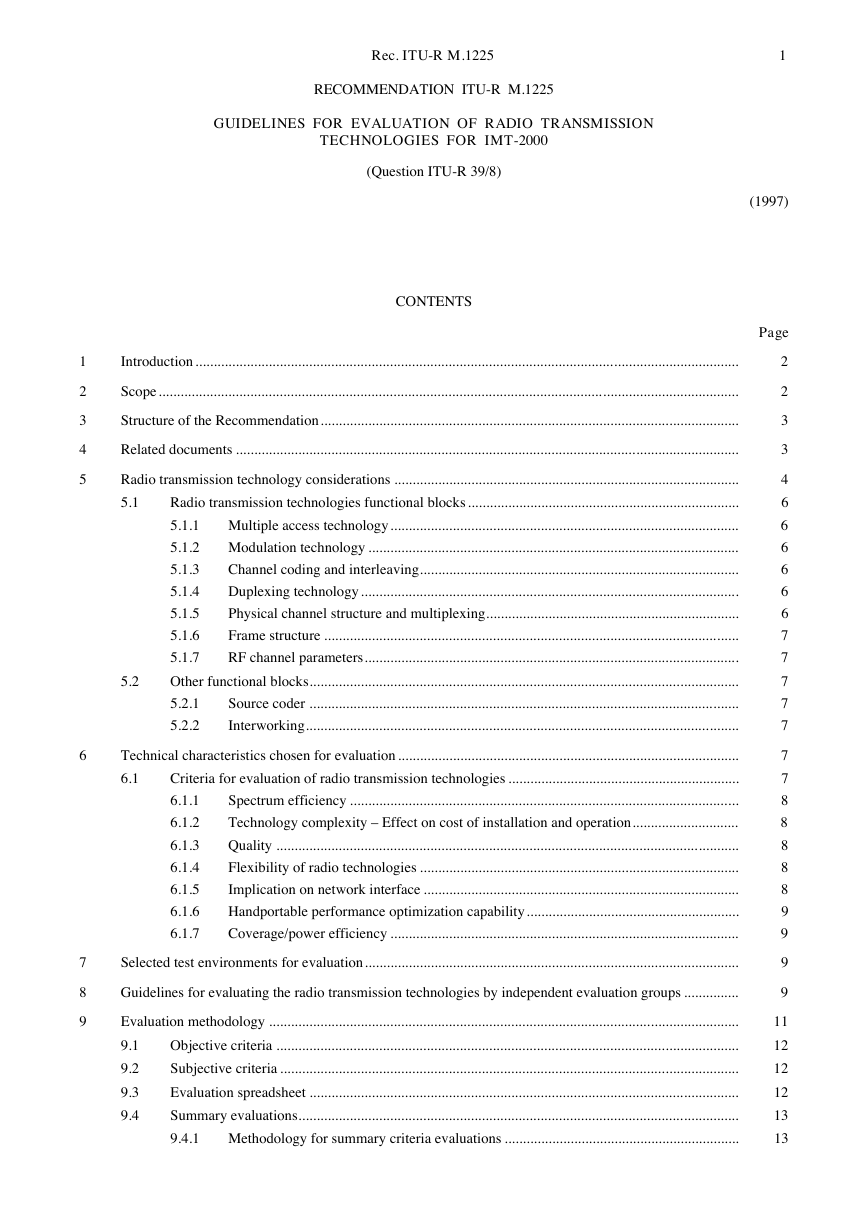
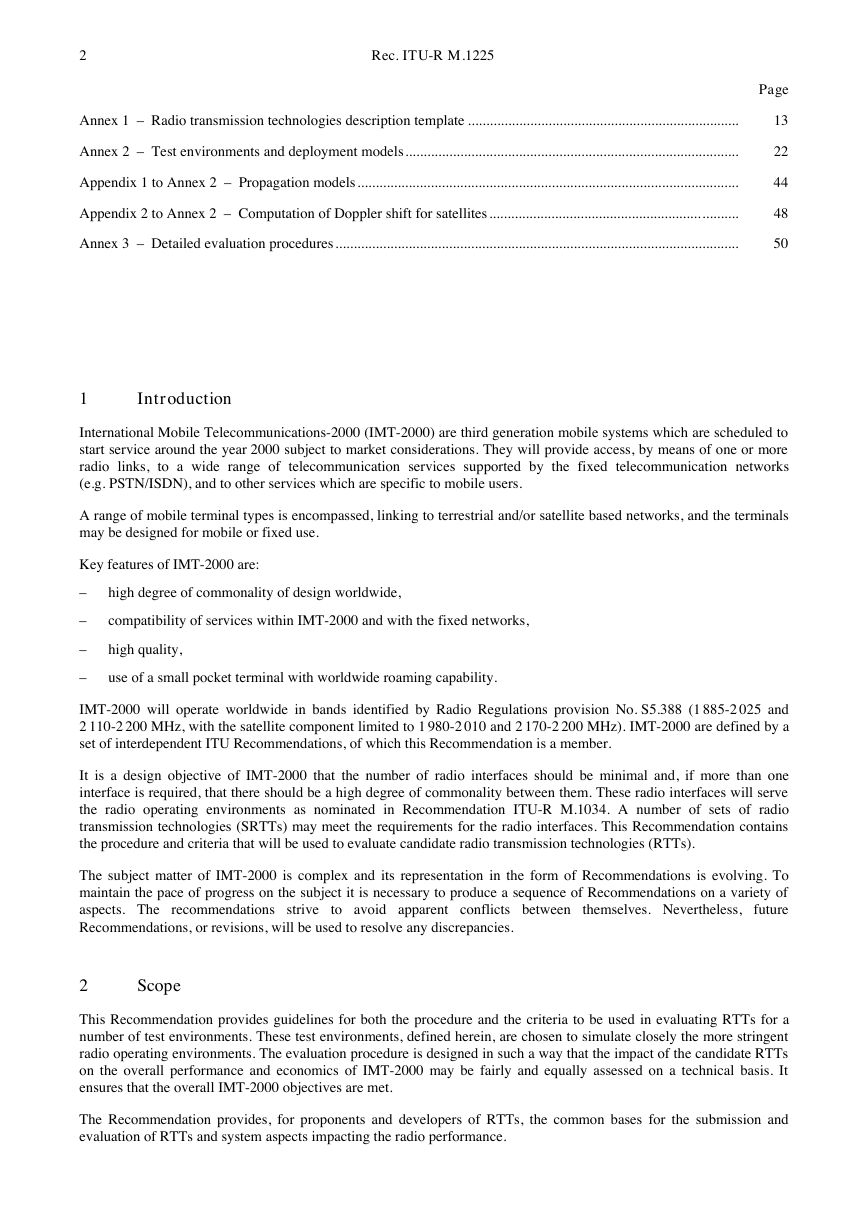
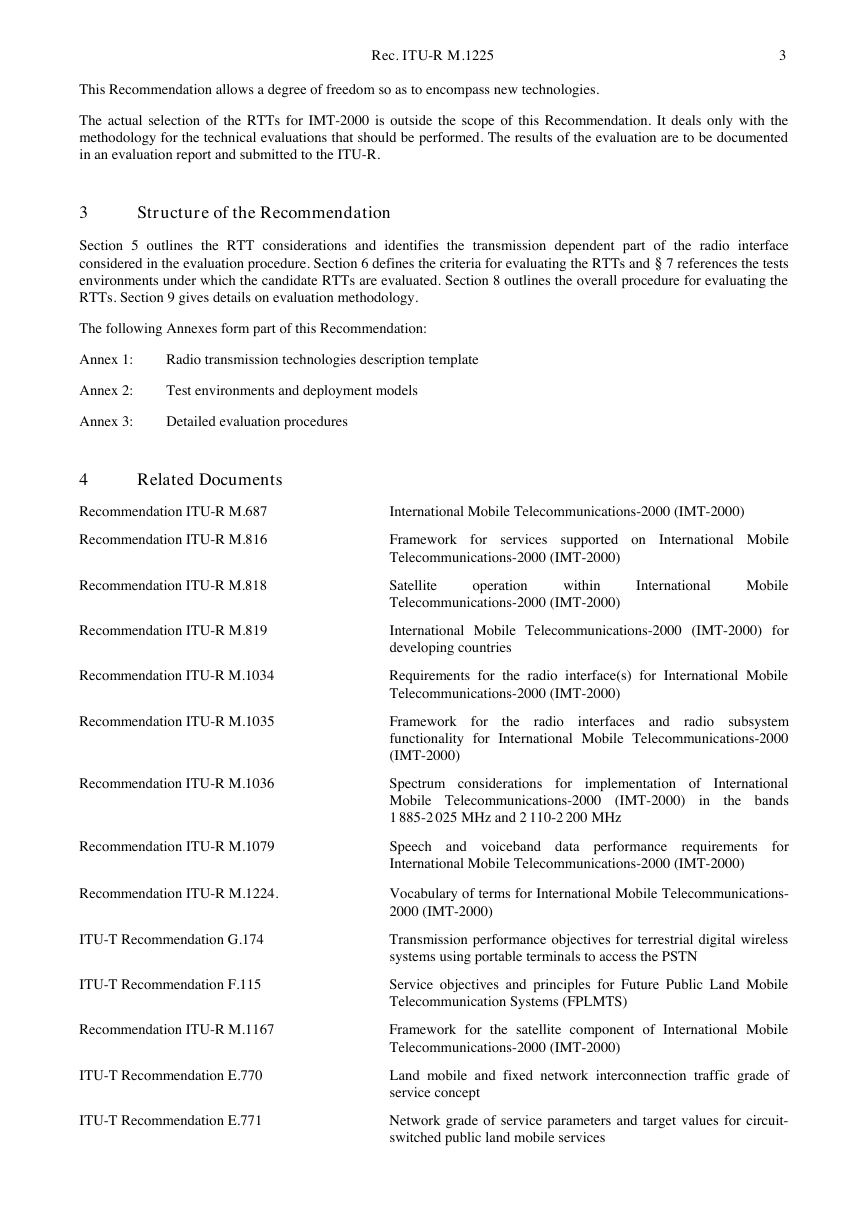
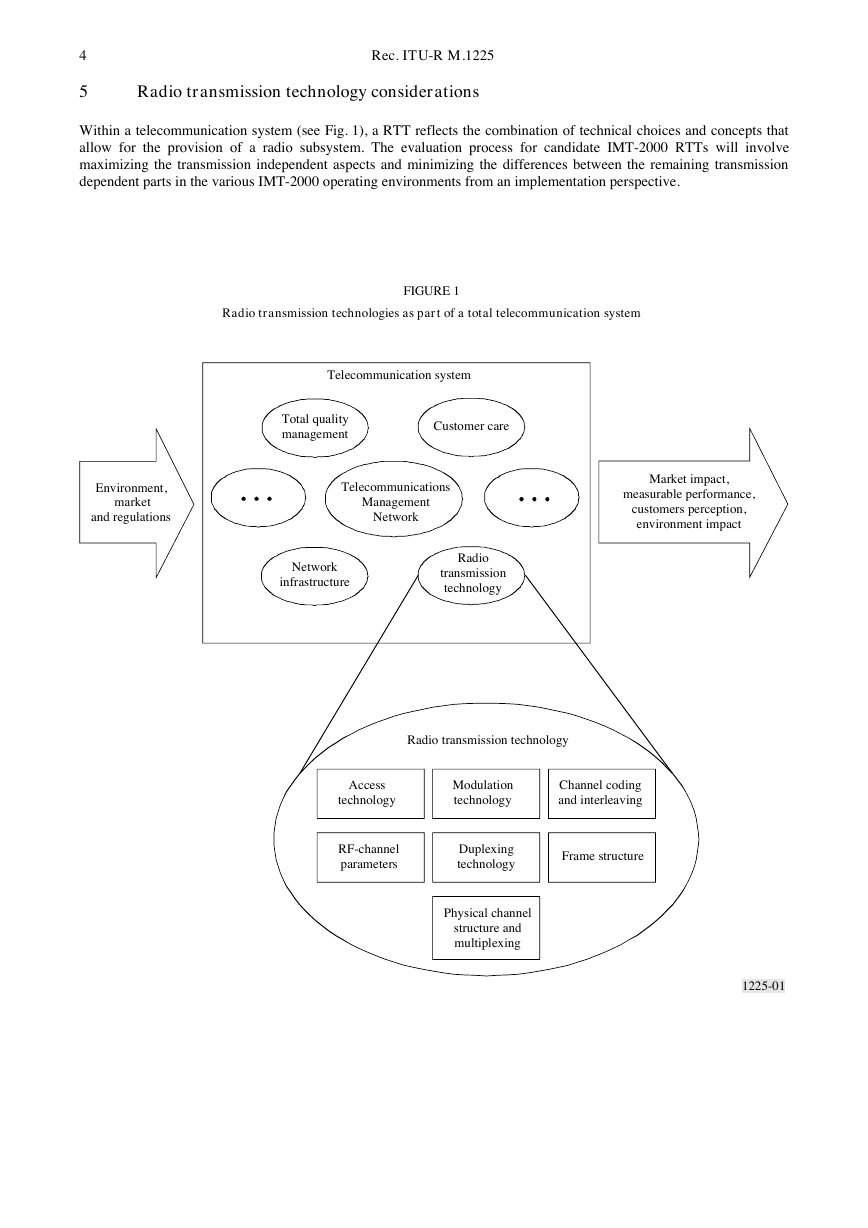
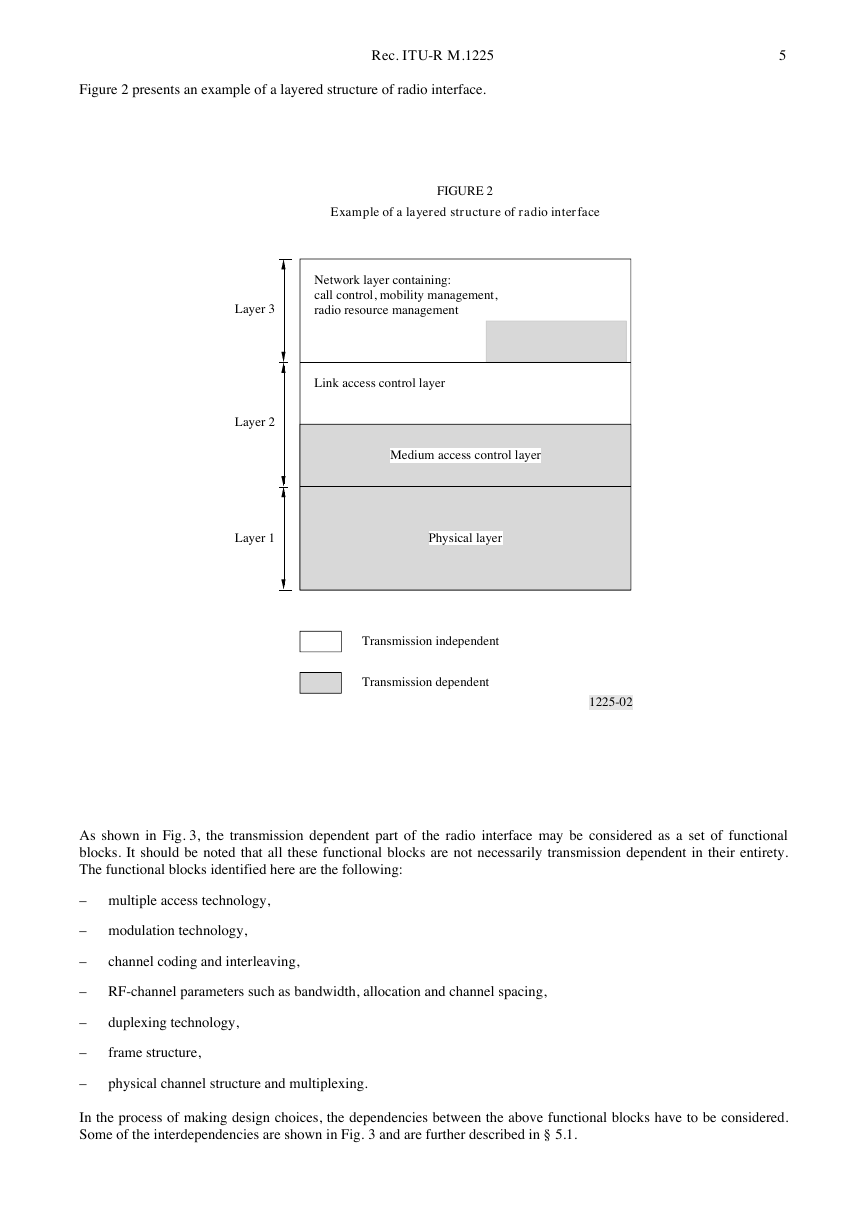
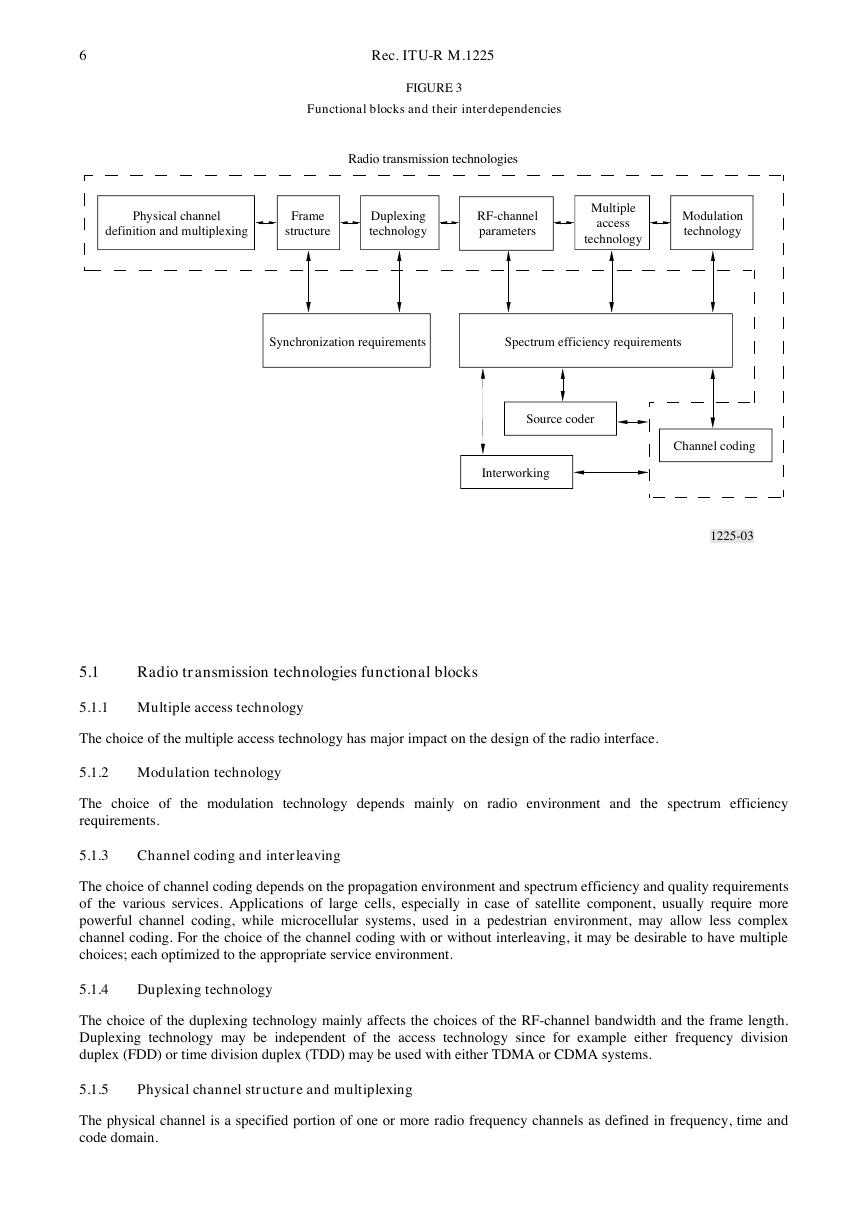
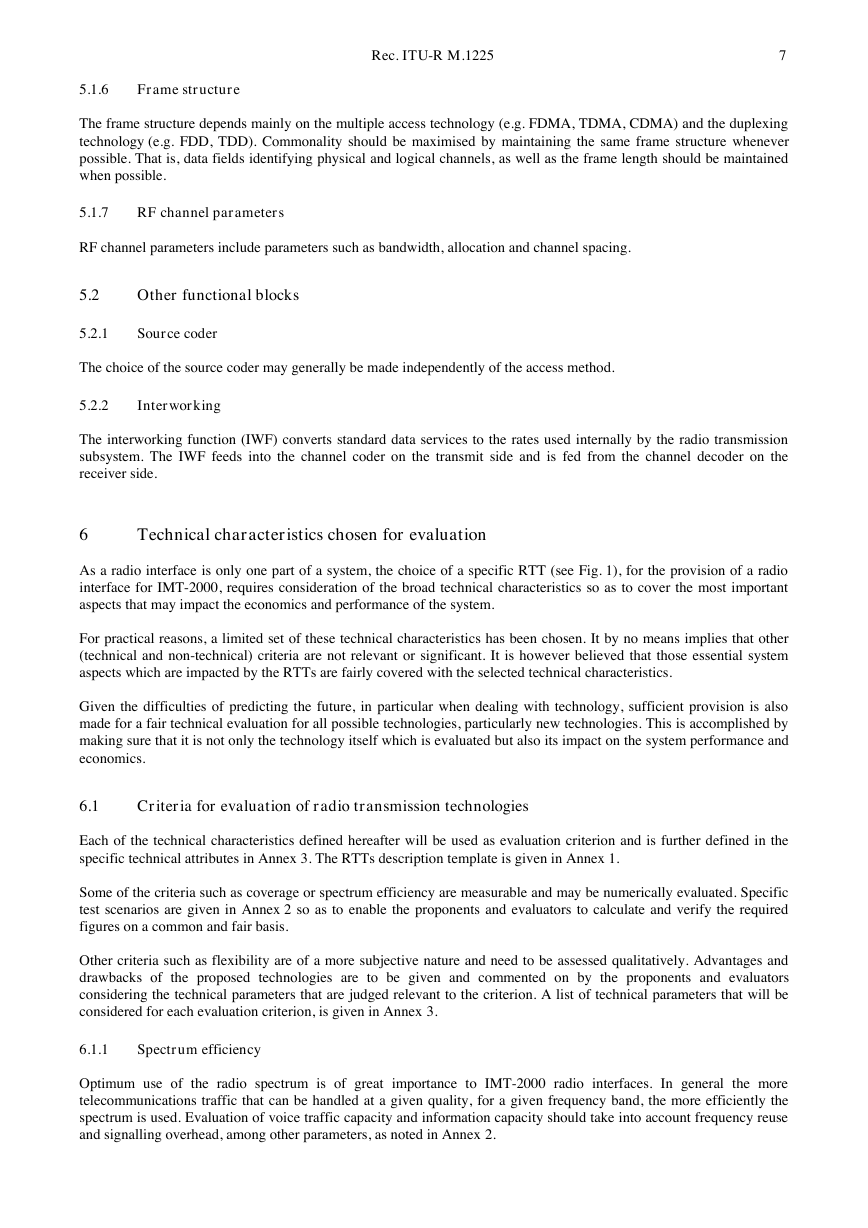
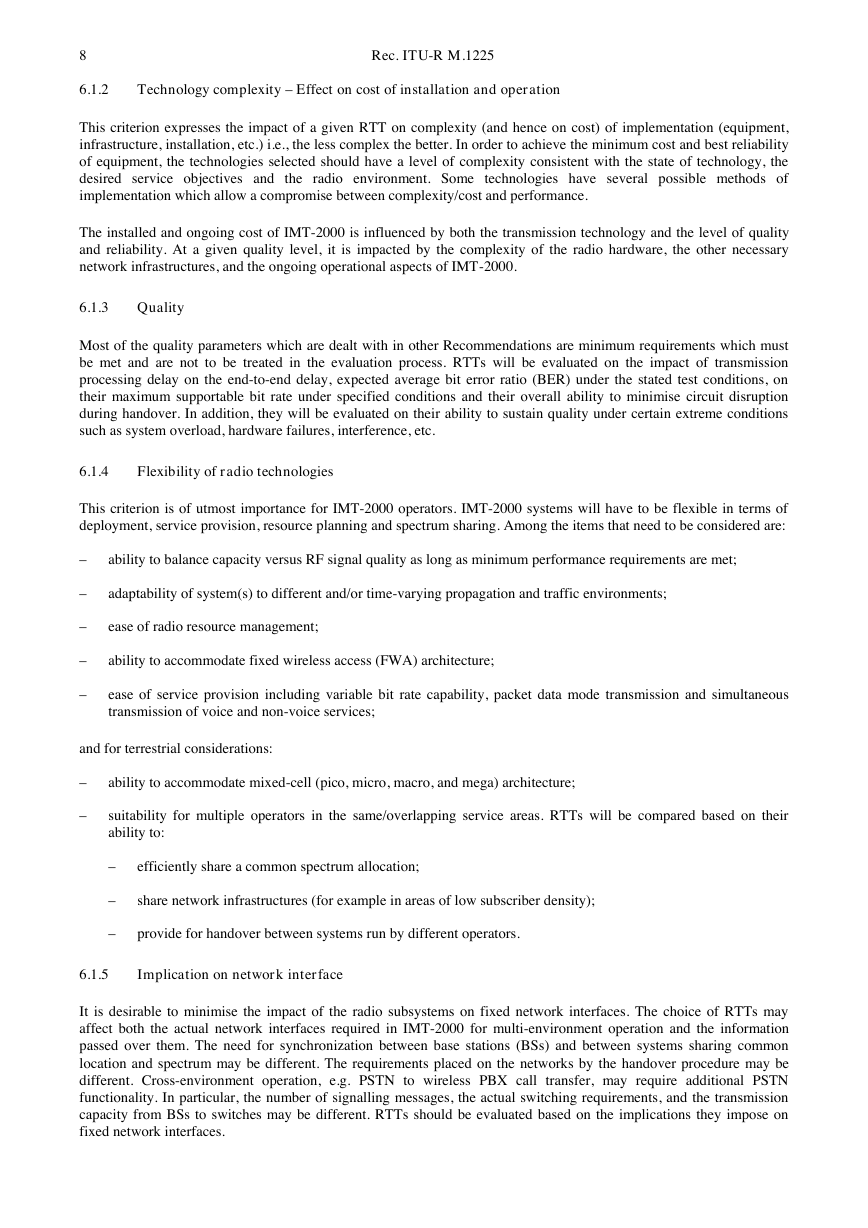








 2023年江西萍乡中考道德与法治真题及答案.doc
2023年江西萍乡中考道德与法治真题及答案.doc 2012年重庆南川中考生物真题及答案.doc
2012年重庆南川中考生物真题及答案.doc 2013年江西师范大学地理学综合及文艺理论基础考研真题.doc
2013年江西师范大学地理学综合及文艺理论基础考研真题.doc 2020年四川甘孜小升初语文真题及答案I卷.doc
2020年四川甘孜小升初语文真题及答案I卷.doc 2020年注册岩土工程师专业基础考试真题及答案.doc
2020年注册岩土工程师专业基础考试真题及答案.doc 2023-2024学年福建省厦门市九年级上学期数学月考试题及答案.doc
2023-2024学年福建省厦门市九年级上学期数学月考试题及答案.doc 2021-2022学年辽宁省沈阳市大东区九年级上学期语文期末试题及答案.doc
2021-2022学年辽宁省沈阳市大东区九年级上学期语文期末试题及答案.doc 2022-2023学年北京东城区初三第一学期物理期末试卷及答案.doc
2022-2023学年北京东城区初三第一学期物理期末试卷及答案.doc 2018上半年江西教师资格初中地理学科知识与教学能力真题及答案.doc
2018上半年江西教师资格初中地理学科知识与教学能力真题及答案.doc 2012年河北国家公务员申论考试真题及答案-省级.doc
2012年河北国家公务员申论考试真题及答案-省级.doc 2020-2021学年江苏省扬州市江都区邵樊片九年级上学期数学第一次质量检测试题及答案.doc
2020-2021学年江苏省扬州市江都区邵樊片九年级上学期数学第一次质量检测试题及答案.doc 2022下半年黑龙江教师资格证中学综合素质真题及答案.doc
2022下半年黑龙江教师资格证中学综合素质真题及答案.doc